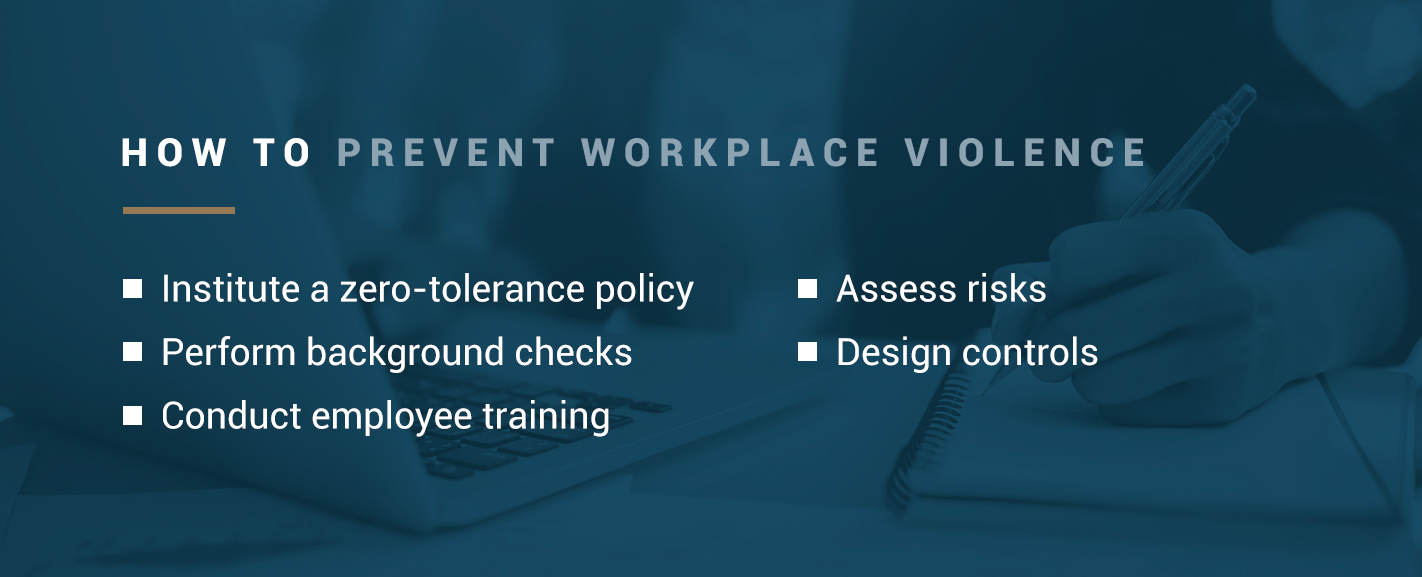Thorough California Workplace Violence Prevention Approaches
Thorough California Workplace Violence Prevention Approaches
Blog Article
Professional Tips on Creating a Robust Office Physical Violence Avoidance Program to Secure Your Employees
In the world of guaranteeing a secure and safe work setting, the advancement of an extensive office physical violence avoidance program stands as an essential undertaking for any kind of organization. The importance of proactively guarding employees from possible risks can not be overstated, and it requires a methodical strategy that encompasses different facets of danger assessment, policy formula, training, reaction methods, and recurring evaluation. By delving right into skilled insights and techniques in these crucial locations, organizations can develop a durable structure to deal with and alleviate the threats linked with workplace violence.
Threat Evaluation
Performing a complete risk analysis is crucial in recognizing prospective sources of workplace physical violence and carrying out reliable precautionary measures. By systematically reviewing the workplace setting, procedures, and interactions, companies can proactively identify locations of worry and take steps to alleviate risks (california workplace violence prevention). During the danger assessment process, it is vital to include crucial stakeholders such as staff members, managers, and safety and security experts to acquire extensive insights into prospective dangers and susceptabilities. Elements such as the nature of the work, geographical place, previous events, and worker feedback ought to be considered when conducting a risk analysis.
Furthermore, making use of tools such as surveys, meetings, and information analysis can provide useful info for evaluating dangers precisely. It is necessary to focus on the determined risks based on their chance and potential impact on worker security. The outcomes of the danger analysis need to educate the growth of a customized work environment violence avoidance program that addresses details susceptabilities and enhances total safety and protection measures. Routine evaluations and updates to the threat analysis are required to adjust to changing situations and make sure the effectiveness of safety nets.
Policy Development
Following the comprehensive danger analysis to recognize prospective resources of office violence, the following critical step is to establish a comprehensive plan for stopping and resolving such events within the organization. A robust work environment physical violence avoidance policy must clearly detail the company's stance on physical violence, define undesirable habits, and establish treatments for coverage, investigating, and minimizing cases. The policy ought to be easily obtainable to all employees, communicated properly, and consistently evaluated and upgraded to ensure its importance and efficiency.

In addition, training programs ought to come with the plan implementation to educate staff members on recognizing caution indications, de-escalation strategies, and appropriate coverage procedures - california workplace violence prevention. By prioritizing policy development as component of a comprehensive workplace violence prevention program, organizations show their dedication to fostering a safe and safe work environment for all staff members
Training and Education And Learning
Just how can companies effectively furnish their workers with the necessary expertise and skills to protect against and respond to workplace violence cases? Training and education and learning are key parts of a durable workplace violence avoidance program. Organizations should supply detailed training sessions that cover various elements of work environment physical violence, consisting of acknowledging indication, de-escalation methods, emergency situation feedback procedures, and reporting procedures. These sessions need to be performed consistently to ensure that employees depend on day with the most recent information and strategies.
Interactive training methods such as workshops, role-playing scenarios, and simulations can aid workers practice their action to different terrible scenarios in a safe environment. Additionally, providing accessibility to online sources, informational materials, and support networks can additionally enhance staff members' understanding and readiness.
It is important for organizations to customize training programs to different roles within the company, thinking about the specific threats and obstacles that staff members may face. By spending in continuous and extensive training and education and learning, organizations can encourage their workers to play an energetic role in avoiding office violence and producing a safe and safe workplace.
Reporting and Feedback Protocols
Efficient application of clear coverage and response procedures is essential in immediately minimizing and resolving work environment violence occurrences. Workers must really feel equipped and motivated to report any type of worrying behavior or prospective risks without fear of revenge. Developing a private coverage system, whether through anonymous hotlines, on the internet platforms, or direct communication with designated workers, can facilitate the reporting procedure and make sure that events are without delay addressed.
Action methods need to lay out a systematic strategy to evaluating reported occurrences, determining the degree of danger included, and applying suitable treatments. This may include collaboration between HR, safety workers, lawful advisors, and psychological wellness specialists to deal with the diverse facets of workplace violence effectively. Training all staff members on exactly how to acknowledge warning indications, react to incidents, and gain access to assistance solutions is vital in creating a culture of watchfulness and readiness.
Regularly updating and evaluating reporting and feedback procedures based upon incident feedback, lawful needs, and finest techniques is important to make sure the performance of the workplace physical violence avoidance program. By promoting a transparent and proactive coverage culture, organizations can much better his comment is here safeguard their workers and preserve a risk-free job environment.
Constant Evaluation

Moreover, carrying out normal drills and simulations to test the effectiveness of action procedures and training programs is vital. These workouts offer beneficial understandings into the readiness of employees to take care of possible terrible situations and permit modifications to be made proactively. Furthermore, seeking input from external professionals or professionals can supply fresh point of views and assist organizations stay abreast of the most up to date strategies and modern technologies for protecting against office physical violence.
Conclusion
Finally, developing a work environment violence prevention program is critical to making sure the safety of workers. By carrying out thorough risk assessments, developing clear policies, offering training and education, implementing reporting and response procedures, and continually evaluating the program, companies can develop a robust system to safeguard their labor force from possible threats of physical violence. It is crucial for companies to prioritize the health and protection of their workers by proactively protecting against and attending to workplace physical violence.
The results of the danger assessment need to educate the growth of a tailored work environment violence avoidance program that addresses particular susceptabilities and enhances general safety and security steps. A durable workplace physical violence avoidance policy should clearly detail the company's stance on physical violence, specify undesirable behaviors, and establish treatments for reporting, click here for info investigating, and mitigating cases.How can organizations efficiently equip their staff members with the essential knowledge and abilities to stop and respond to workplace violence events?In verdict, creating advice a work environment physical violence avoidance program is important to ensuring the security of staff members. It is important for employers to focus on the health and protection of their employees by proactively preventing and dealing with workplace violence.
Report this page